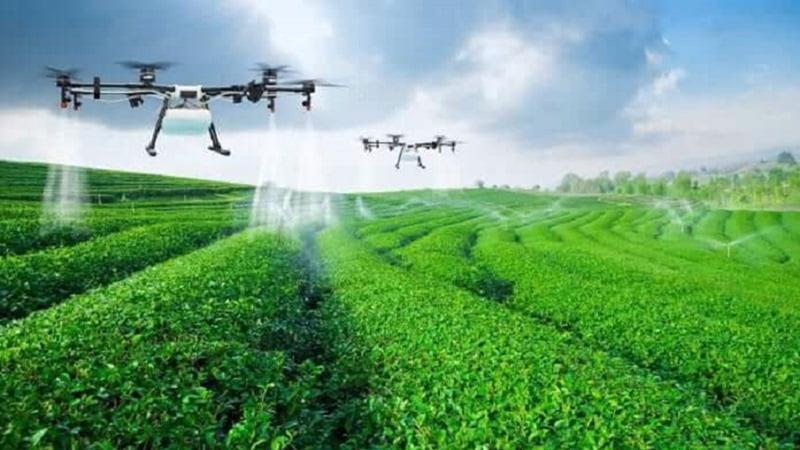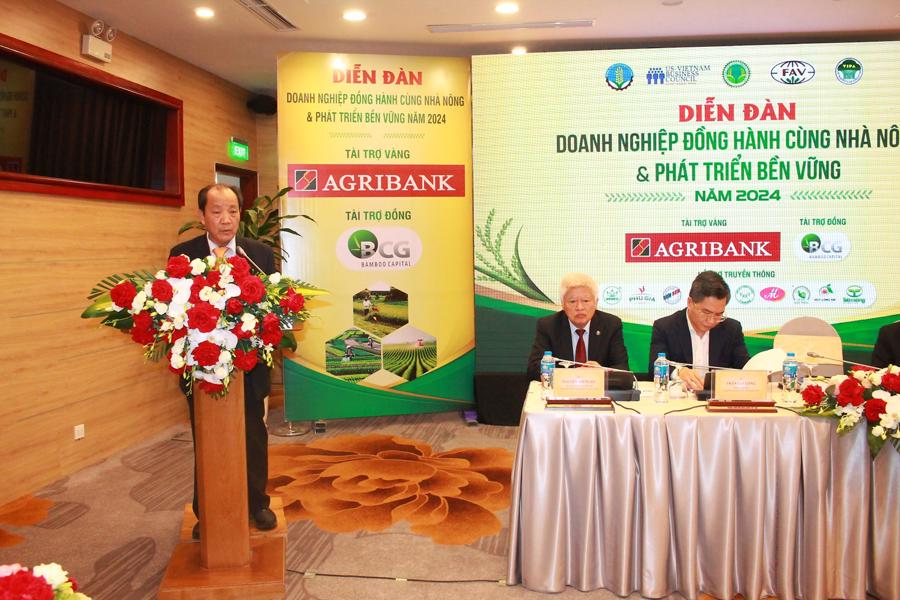
Agricultural advances have helped farmers use the correct types and amounts of fertilizers and pesticides.
On the afternoon of April 9, 2024, the Vietnam General Association of Agriculture and Rural Development organized a forum on Enterprises accompanying farmers to develop sustainable agriculture in 2024.
ENTREPRENEURS PLAY AN IMPORTANT ROLE IN DEVELOPING GREEN AGRICULTURE
Speaking at the forum, Mr. Ho Xuan Hung, Chairman of the Vietnam General Association of Agriculture and Rural Development, said that in the first 3 months of 2024, agricultural, forestry and fishery exports reached 13.53 billion USD, an increase of 21.8% over the same period last year. To achieve that result, Enterprises have been playing a very important role in the value chain of the agricultural and rural development sector.
However, Mr. Ho Xuan Hung said that in fact, by the end of 2023, the whole country had about 50,000 enterprises investing in agriculture, compared to the total number of over 900,000 enterprises operating in our country, this is a quite modest number.
“Is it because the mechanism and policies to encourage and support enterprises to participate in the agricultural and rural sector are not strong enough, the way to mobilize, call for, and create conditions for enterprises is not really good, so it is still not attractive and appealing to enterprises. The connection between enterprises and farmers is not really good, farmers are still passive from production to product consumption”, Mr. Ho Xuan Hung asked.
Mr. Ho Xuan Hung: “Enterprises have been playing a very important role in the value chain of the agricultural and rural development sector”.
Dr. Tran Gia Long, Deputy Director of the Department of Planning, Ministry of Agriculture and Rural Development, said that the structure of agricultural sectors is shifting rapidly. Of which, the proportion of cultivation has decreased from 56.9% in 2011 to 43% in 2023; while aquaculture has increased from 18.07% to 22.11%; livestock from 19.6% in 2011 to 25.2% in 2023.
Agricultural production is moving towards sustainable production, increasing the application of safe and sustainable production standards to contribute to improving product quality; processing technology for many industries is on par with regional and international levels.
“The trends of green agricultural production, organic agriculture, ecological agriculture, emission-reducing agriculture, weekly agriculture… are developing strongly. Therefore, businesses need to demonstrate their role in leading agricultural product chains towards green, safe and emission-reducing agriculture”, Mr. Long emphasized.
Dr. Phung Ha, Vice President and General Secretary of the Vietnam Fertilizer Association, said that agriculture is affected by climate change, but is also the second largest greenhouse gas emitter after the energy industry. The main greenhouse gas emissions in agriculture include N2O, CH4 and CO2… contributing about 13.5% of total emissions.
“Foliar fertilizer products (PBL) containing K, Ca, Mg, Si help plants increase resistance, increase drought tolerance, withstand salt stress, strengthen plants, and prevent them from falling. Many fertilizer products have added amino acids to increase the plant’s resistance to salt”.
Dr. Phung Ha, Vice President and General Secretary of the Vietnam Fertilizer Association.
N2O emissions account for 32% of greenhouse gas emissions in agriculture, mainly due to the use of excess urea fertilizer. CH4 gas is generated from rice cultivation and land use, from the digestive system of ruminants (buffalo, cows, sheep, goats) during the intestinal fermentation process. CO2 gas is generated from fuel combustion for machinery operating during soil preparation, planting, harvesting, etc.
According to Mr. Phung Ha, fertilizer production enterprises have taken measures to significantly reduce carbon emissions in production and are continuously striving to improve energy efficiency. Some fertilizer companies have initially implemented “greener” fertilizer production methods. That is, widely developing special fertilizer forms such as slow-release/release fertilizers, controlled decomposition to help increase fertilizer absorption by crops, while reducing environmental impact.
Along with that, managing crop nutrition, promoting better combination between locally available organic fertilizer sources such as manure and compost with mineral fertilizers. Promoting research and development of green ammonia, green chemistry; Focus on management methods, adjusting nutritional composition according to plant needs to reduce loss to the environment…
SOLUTIONS TO REDUCE THE TOXICITY OF PESTICIDES
Mr. Nguyen Van Son, Chairman of the Vietnam Pesticide Production and Trading Association, said that switching from chemical pesticides to biological pesticides is one of the solutions for green agriculture. Some preparations containing active ingredients azadirachtin, matrine, rotenone used to prevent thrips and other pests on rice, vegetables, fruit trees, tea and many other crops have been registered.
However, not many biochemical products with biological properties have been registered. The development of biological pesticides still faces many difficulties, because the State does not have appropriate and strong enough policies to encourage research, production, trading and use of biological pesticides.
“In 2019, the Vietnamese biological pesticide market is estimated to reach a value of 30.7 million USD; in 2024, it is expected to reach 65.7 million USD, a growth rate of over 16.4%/year”,
Mr. Nguyen Van Son, Chairman of the Vietnam Association of Pesticide Production and Trading.
In addition, the registration procedures for biological pesticide products are still cumbersome and cumbersome, and there is a lack of specific regulations on technical requirements for highly specialized biological pesticides. Using biological pesticides is still more expensive than chemical pesticides. Meanwhile, there is no connection between research institutions and businesses in the field of developing biological pesticides.
From the above reality, Mr. Nguyen Van Son recommended reviewing the registration procedures and requirements on quality indicators in accordance with the reality in Vietnam, creating conditions for the development of biological pesticides.
At the same time, it is necessary to supplement policies to support and encourage organizations and enterprises to develop strong enough human resources to research, produce and transfer technology for the production of household pesticides.
The State needs to support enterprises to invest in modern technology on a large scale, reduce product costs so that farmers can easily accept it. Support and encourage organizations and individuals to invest in the development of production and use of biological pesticides, reduce interest rates on loans to invest in equipment and factories for research and production of biological pesticides.
Mr. Phan Huy Thuy, Deputy Marketing Director of Truong Thinh Technical Trading Company Limited (TTDRONE), said that in recent years, advances in precision agriculture have provided a series of technologies to help farmers use the correct type and amount of fertilizers and pesticides. In particular, agricultural drones are a widely used technology product, helping to reduce the amount of pesticides used and the harmful effects of chemicals.
However, according to Mr. Thuy, in order for a product to be recognized as an agricultural product, the enterprise must have the product appraised by an independent unit to be confirmed as an agricultural drone. However, the next import must also be appraised (the current regulation is to appraise by shipment), while the goods are the same product, with the same product code. Therefore, it is recommended that the State change the regulations, allowing products to be appraised once. Appraisal only once will help businesses operate quickly and reduce costs.
According to regulations, in the flight notification (in coordination with local management agencies), it is necessary to list the locations and expected times for performing the service. However, the characteristics of the crop farming industry are that it is sometimes urgent, and it is difficult to predict the occurrence of pests, so the occurrence of flight locations outside the list is likely to occur.
“Some localities (especially district level) occasionally require separate forms, and if they are different from the form, they will not consider granting a license. Enterprises really need the support of state management agencies to be flexible in ignoring small issues (such as forms), and can remind enterprises to do it more correctly next time,” Mr. Thuy suggested.

